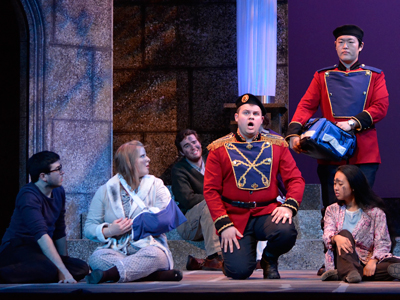by J.D. Goddard

A tale of sexual obsession and divided loyalties set in Ancient Rome, La clemenza di Tito was Mozart’s last opera, written during the composition of The Magic Flute, and a only a few months before his death in 1791. Though it was hastily composed on commission for the coronation of the King of Bohemia, Mozart lavished music of sensuous beauty and originality on the work, even though his heart seemed not to be into the pompous, self-absorbed character of the Emperor Tito.
Though its duets, trios, and first- and second-act finales compare equally with anything from Così, Figaro or Don Giovanni, several of the big arias in Tito seem to hark back to an earlier style. And due to the press of time, Mozart turned the job of composing the recitatives over to his student Franz Xavier Süssmayr, who would later complete his master’s Requiem. John Simmons’s stylish realizations at the harpsichord for this production did much to redeem their flaws.
Director David Bamberger’s adroit staging allowed his talented singers to enjoy their own individual moments of vocal prowess. The entrance of the chorus down the aisles carrying signs and placards during the overture was an interesting but distracting touch.
Dave Brooks’s set and lighting were frugal and to the point, while Alison Garrigan’s eclectic costuming left this reviewer confused about the time period being portrayed. It wasn’t ancient Rome, but the printed program gave no clues.
The CIM opera students were excellent singers and actors, and their attention to detail was obvious. The six major leads were well-matched. Brian Skoog (Tito) seemed to be challenged by the florid passages of “Se all’Impero,” but otherwise, sang with solid-toned suavity and formidable technique as he tried to bring the Emperor to life.
The resonant Laurel Weir (Vitellia) also faced some technical hurdles that she overcame with ease. She dominated the stage, and her voice echoed throughout Kulas Hall with absolute clarity. She sang “Non più di fiori” with panache and bravura. Elizabeth Frey (Sesto) gained confidence as the show progressed, producing an impassioned account of her florid, second-act showpiece.
Charlotte Ushella and Allyson Dezii as the young lovers Annio and Servilia, and Panajotis Pratsos as the staunch Publio also deserve a round of applause for their fine work. Kudos also to principal clarinetist Jaewon Kim.
While fewer pauses between recitatives and arias would have helped move the action along more convincingly, this was a generally well-paced and enjoyable show. It’s always a pleasure to hear and see such exceptional young talent perform.
Photos of the Thursday-Saturday cast courtesy of CIM.
Published on ClevelandClassical.com March 2, 2015.
Click here for a printable copy of this article




